LONG BEACH CURRENT
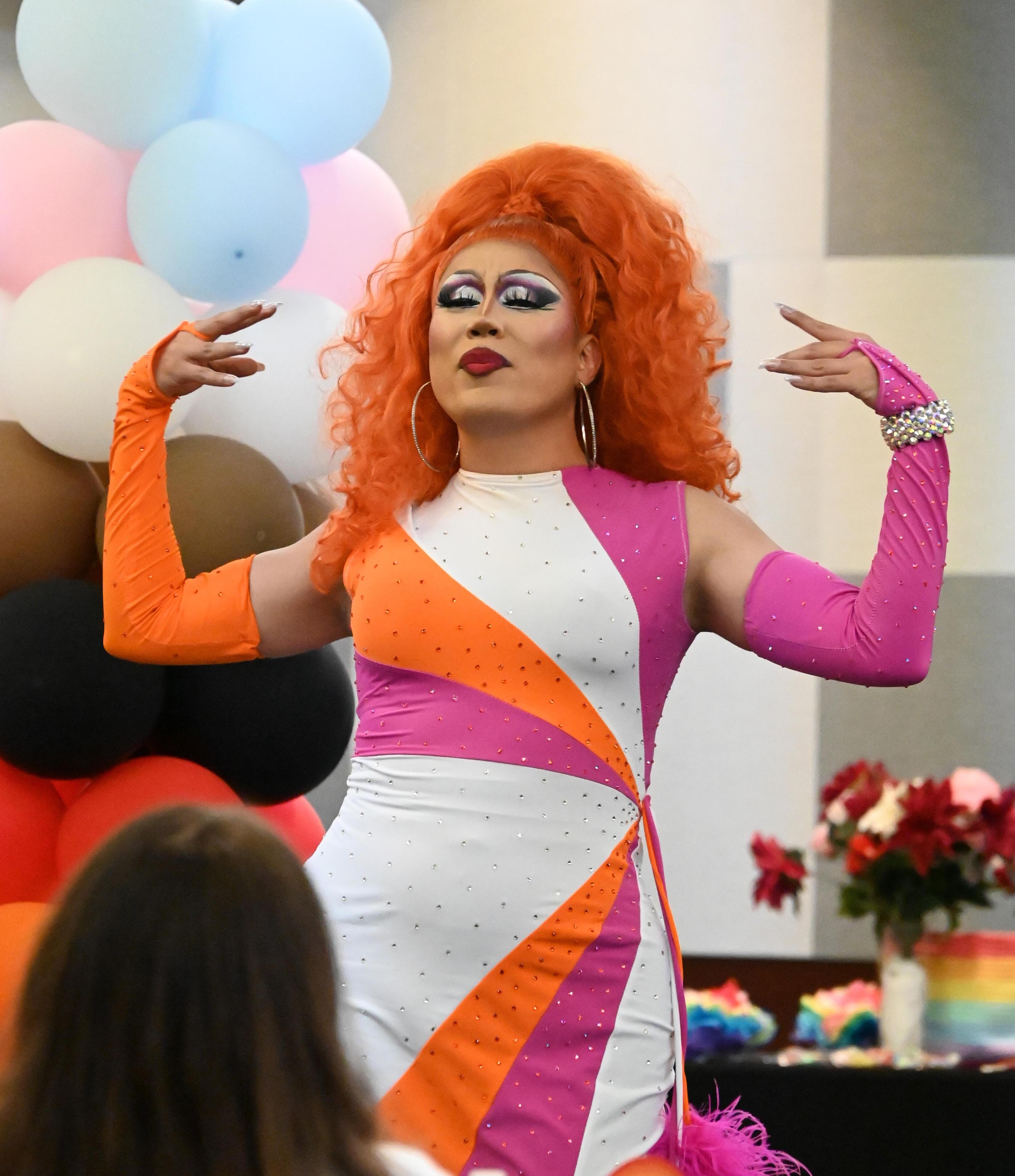



REHANSA KULATILLEKE/Long Beach Current CSULB alumnus, Natasha Hundreds performs Chappell Roan's hit song, "Good Luck, Babe!" during CSULB's Drag Loteria in celebration of OUTober at The Pointe on Oct. 7.

ETHAN COHEN/Long Beach Current
Students walk past the Go Beach sign towards a detour around the under-construction USU building on Aug. 27.
BY ANGELA OSORIO AND ANNETTE QUIJADA Chief Copy Editor & News Editor
ACSULB student was killed Saturday morning in an off-campus stabbing that involved three roommates, police say.
Long Beach Police arrived at the 1300 block of Temple Avenue around 10:30 a.m. on Saturday, Oct. 4.
Two men were found on the scene with upper stab wounds. One of the men, identified as Spencer Timms, 22, was pronounced dead at the scene. The other victim, 29, was taken to a local hospital in stable condition.
Alejandro Iniestra, 34, was arrested on charges of murder and is being held for a $2 million bail.
Land acknowLedgment
A police investigation suggests the three men were roommates.
Timms was a senior industrial design student at CSULB who transferred from Saddleback College.
Royce W. Smith, the dean for the College of Arts, sent an email statement to students in the Department of Design on Oct. 8.
"It is with a heavy heart that I share with you that one of our Department of Design and College of Arts students, Spencer Timms, passed away in Long Beach this past Saturday," Smith said in the statement.
Smith said Timms was an "incredibly positive and impactful student, maintaining a 4.0 GPA during his time at CSULB and sharing a passion for design."
"I remember quite well meeting Spencer on one of my visits to the department and clearly recall seeing and admiring the creative fire in him and his work," Smith said in the statement. "A student who knew he had something special to offer and who put all of himself into honing his talents and focusing his ambition."
Here at the Long Beach Current we acknowledge that the school we report on is located on the sacred site of Puvungna, “the gathering place.” We are on the land of the Tongva/Gabrieleño and the Acjachemen/Juaneño Nations who have lived and continue to live here.
We also acknowledge the Gabrieleño/Tongva (pronounced: GABRIEL-EN-YO/TONG – VAH) and Acjachamen/Juaneño (pronounced: AH-HACH-AH-MEN/JUAN-EN-YO) as the traditional custodians of the Los Angeles region along with the Chumash (pronounced: CHOO-MOSH) to the north and west, and the Tataviam (pronounced: TAH-TAH-VEE-YUM) and Cahuilla (pronounced: KAH-WEE-YAH) Nations to the east.
We respect and value the many ways the Tongva/Acjachemen cultural heritage and beliefs continue to have significance to the living people and remind us about the sacred and spiritual relationship that has always existed here at what we now call California State University Long Beach.
editoriaLs: All opinions expressed in the columns, letters and cartoons in the issue are those of the writers or artists. The opinions of the Long Beach Current are expressed only in unsigned editorials and do not necessarily reflect the opinions of the journalism department or the views of all staff members. All such editorials are written by the editorial board of the Long Beach Current.

Letter PoLicy: All letters and emails must bear the phone number of the writer and must be no more than 300 words. The Long Beach Current reserves the right to edit letters for publication in regard to space.
Monday,
1250 Bellflower Blvd., LA4-203 Long Beach, CA, 90804
Editorial Office
Dante Estrada
Grace Lawson
Community Engagement Editor
Isabella Garcia Khoury Williams
Managing Editor Editor-in-Chief
Haley Lopez
Business Manager
Multimedia Managing Editor business@gobeach.media managing@lbcurrent.com eic@lbcurrent.com community@lbcurrent.com multimedia@lbcurrent.com
Annette Quijada news@lbcurrent.com News Editor
Delfino Camacho arts@lbcurrent.com
Arts & Life Editor Leyna Vu opinion@lbcurrent.com Opinions Editor
Sports Editor
Design Editor
Chief Copy Editor
Photo Editor
Social Media Editor
Video Editor
Podcast Editor
Phone (562) 985-8000 editors assistants advisers
Timothy Hessen sports@lbcurrent.com
Luis Castilla design@lbcurrent.com
Angela Osorio copy@lbcurrent.com
Charlotte LoCicero photo@lbcurrent.com
Erinna Lam social@lbcurrent.com
Skylar Stock video@lbcurrent.com
Gianna Echeverria podcast@lbcurrent.com
News Assistants Ethan Brown
Anna Kuchison
Jayden Sandstrom
Joshua Flores
Nasai Rivas
Arts & Life Assistants Ni Baliness
Jason Green
Michael Heiter
Lila Mukasa
Opinions Assistant Joshua Min
Sports Assistants Monica Badolian
Xavier Constantino
Brianna Apodaca Alan Ibarra
Junior Contreras
Design Assistants
Brooke Williams
Rebecca Lavond
Leyla Crail Copy Assistants
Photo Assistants
Sasha Marantz
Diego Perez
Eddy Cermeno Rehansa Kulatilleke
Jorge Hernandez
Ethan Cohen
Social Media Assistants Bella Beltran
Valentina Villarreal
Video Assistants Mikaela Perez
Kiara Fillingim
Nala Tucker
Bryan Viteri Podcast Assistants
Victor Alcocer
Ava Richards
Brandon Rodriguez
Business
Brendan Nelson Advertising Manager advertising@gobeach.media
Alicia Taylor Creative Manager
Anita Demirci Web & Technology Manager
web@gobeach.media creative@gobeach.media
Ericka Lacy PR & Marketing Manager
Distribution Manager
Seiana Spencer-Kendrick
Josephine Kim distribution@gobeach.media pr@gobeach.media
Gary Metzker Design Adviser
Barbara Kingsley-Wilson Content Adviser
Jennifer Newton Advertising & Business Adviser
BY JAYDEN SANDSTROM News Assistant
Over 30 new faculty members have joined Long Beach State this year, including professors in the College of Engineering, College of Business and College of Liberal Arts.
A Navy veteran and L.A. native, Laura Sandoval joined the College of Engineering this year as an associate professor. Her experience as a mechanic in the Navy set her on the path toward engineering.
“The transition from military to civilian was really tough, but I really think that I succeeded because I had a really good student veteran organization that helped me transition, and I’m hoping to help set something similar up here to support student veterans,” Sandoval said.
This, along with her desire to give back to the Latinx community, is what drew her to become a professor at CSULB.
Like Sandoval, Robert Mejia, an asso-

The Beach welcomes a new wave of faculty members, bringing fresh perspectives, new talent and innovation to campus.
ciate professor in the communications department, also felt a strong personal connection to the campus.
As a CSULB alumnus, Mejia earned his bachelor’s in English and communication, followed by his master’s in communication studies at CSULB, before completing his doctoral degree at the University of Illinois.
Since then, he has taught classes at USC, North Dakota State University and UC Santa Barbara.
“I wanted to return to CSULB because the student population here meant so much to me as an undergraduate student, and it means so much to me as a professor to work at a historically Hispanic-serving institution. Not only that, but the student body consists of many first-generation students who are really paving their own way, and it’s an exciting and energetic thing to be a part of,” Mejia said.
For Elaine Tamargo, an associate professor in the educational leadership department, the path to the university began in 2024. She had been career counseling at UCLA while finishing up her
doctoral degree.
When she saw a vacant position open at CSULB, she decided to apply even though the deadline had already passed.
“I grew up not too far away from Long Beach, and I’ve worked at other Cal States before. I had heard about the education department’s great reputation, which really drew me to apply, and I strongly believe in the Cal State mission of social mobility,” Tamargo said
CSULB’s Provost, Kathryn Gunn, is responsible for overseeing all academic affairs through ensuring faculty excellence and advancing student engagement and retention.
The Office of the Provost looks for faculty members who can help shape the academic agenda for years to come. This is done by looking at past achievements and evaluating their potential to continue engaging in excellent instruction and worldclass research, Gunn said.
“There are a couple of considerations when we hire faculty each year. The first is called general recruitment, which is designed to identify faculty members
who have expertise that complements or strengthens existing curricular offerings.” Gunn said. “If there is a need for a certain program, a series of courses within a program or a particular research agenda, then we try to identify faculty members who can fill those roles.”
Another hiring initiative the university has implemented is the ‘cluster hire,’ which has been in place for the past three years.
According to Gunn, faculty are recruited from a wide range of disciplines based on their research expertise and the ways their interdisciplinary work can collectively address major societal challenges.
The university has faced budget cuts with a 3% decrease in state funding. Gunn said the university has been fortunate that they have not impacted its ability to retain or hire new faculty.
She added that CSULB’s strength within the California State University system has allowed it to navigate the reductions without making staffing sacrifices.
“Despite these challenges, we are committed to continuing to hire faculty [who] reflect the students we serve,” Gunn said.
BY JOSHUA FLORES
News Assistant
Campus convenience stores are a staple for students, offering a variety of caffeinated drinks, savory snacks and more. However, ongoing construction and the closure of several restaurants have added pressure on the remaining stores to satisfy students.
With a record student enrollment this fall and a multi-year-long Future U project displacing dining options in the University Student Union, the remaining convenience stores on campus are dealing with an influx of students and long lines.
“We haven’t necessarily seen an increase in sales, but we have definitely seen an increase in traffic,” said Cyndi Farrington, chief business officer for Beach Shops. “The products are selling; if people don’t like stuff, they’ll buy it once, but that’s it.”
With longer lines and fewer places to shop due to the USU closure, students have had to find workarounds.
“It used to affect me, but then I tried to find the locations that have a microwave around campus and kind of found somewhere without many people,” Iris Tran, fourth-year marketing major, said. “I bring my own food…sometimes I go here for soft drinks or some candies, [but] I come here for the microwave.”
Before the start of the semester, Long Beach State made preparations to account for these changes and has kept up with student demand, according to Shannon Couey, Associated Students, Inc. communications manager, via an email exchange with the Long Beach Current.
“I’ve worked at both the Outpost and the Beach Hut, and each store has seen an increase in customers. Peak times are typically between noon and 2 p.m. for lunch,” said Haley Bathurst, Long Beach State alumnus and retail associate. “The Outpost also experiences a surge after 6 p.m. due to nearby night classes, as it is one of the few food options available in that area.”
Despite the increased crowds, Beach Shops has not experienced any product shortages at its stores. Beach Shops is also contracted with a new sushi vendor, Red Shell Sushi, after the previous vendor, Wild Blue, decided to cease its sales.
Feedback has been positive about the
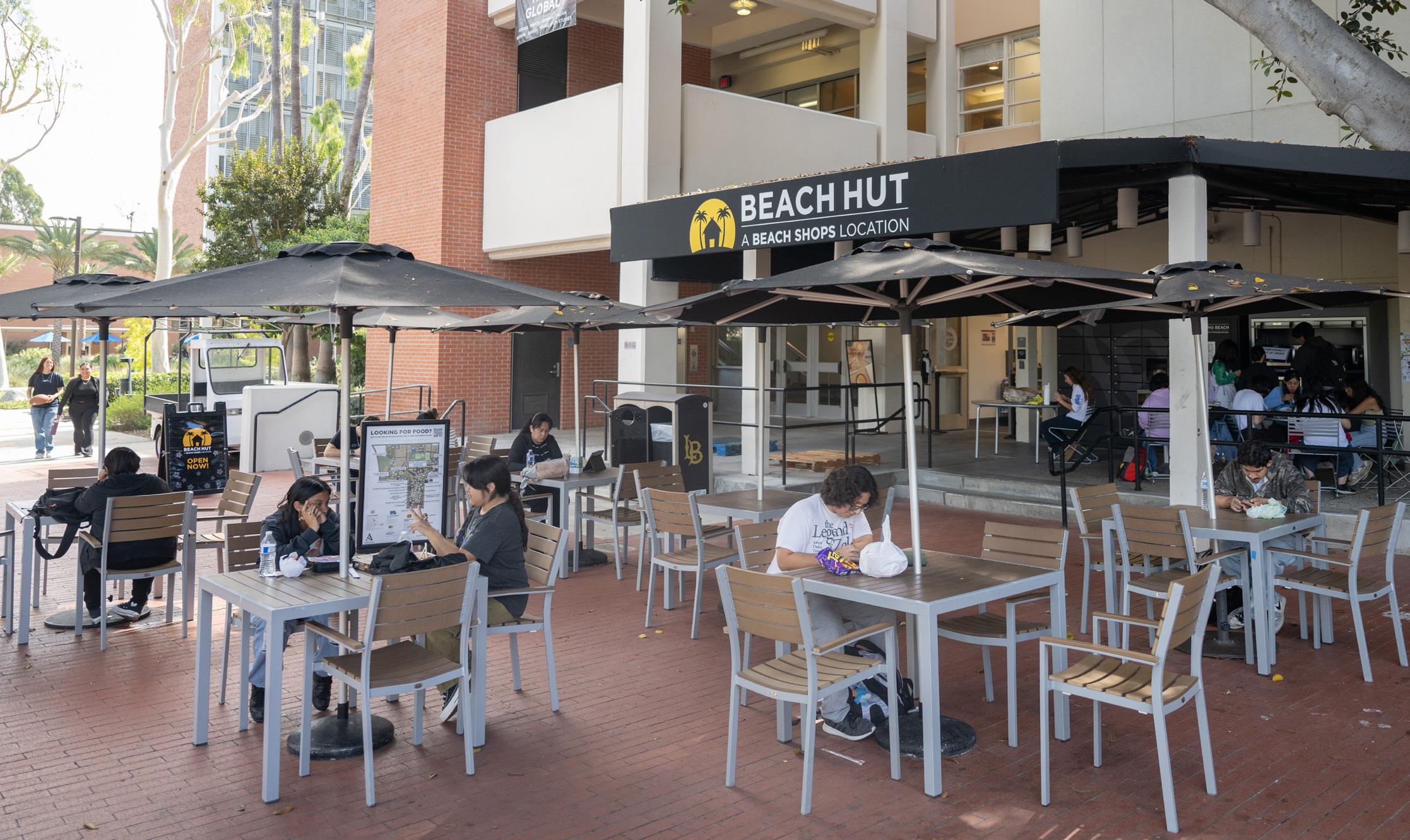
new sushi vendor, according to Farrington.
“We’ve been able to keep locations consistently stocked with all the essentials […] since reopening on Aug. 25, we’ve seen daily increases in traffic across our convenience store locations,” Couey said.
In anticipation of the Future U project, Couey said that all Beach Shops stores added more fresh and frozen food options to their regular supply of goods.
The expanded food options at convenience stores are limited to items like salads, sushi, sandwiches, wraps, various bowls and more, with a lack of hot food options aside from microwaveable meals.
“I think they should have more fresh food, more than instant food, but I don’t know how they would do that, but I would prefer something fresh and hot,” Tran said. “It’s always instant food, so I go here for the Buldak ramen as well; it’s very popular.”
The Beach Hut on upper campus, next to the Academic Services building and University Library, reopened this semester and will serve soup by the end of October, according to Farrington. Soup was available before the store’s conversion to Am-
azon’s Just Walk Out store system in 2023.
“Feedback has been very positive,” Couey said. “Faculty and staff in the AS building especially appreciate the options nearby, and students value having a location close to their classes that’s also open late.”
According to Couey, the Amazon format was not popular with many on campus due to its limited options, so it switched back to a convenience store model this semester.
“This one used to be like the Amazon one last semester that I was here, so it kind of threw me off when I saw that this one was the Beach Hut now,” third-year English education major Kayla Bustos said. “I liked it, I feel like it was easy and convenient, if I didn’t want to buy anything, I just walked out.”
Despite the change, the Beach Hut is still Bustos’ most frequented store.
Current convenience store options on campus:
The Art Store at the College of Arts:
• Monday - Thursday: 8 a.m. to 7 p.m.
• Friday: 8 a.m. to 4 p.m.
• Saturday - Sunday: Closed Beach Hut near Academic Services and the Library:
• Monday - Thursday: 7 a.m. to 10 p.m.
• Friday: 7 a.m. to 4 p.m.
• Saturday: 10 a.m. to 4 p.m.
• Sunday: noon to 8 p.m. Bookstore Convenience Store at the University Bookstore:
• Monday - Thursday: 7 a.m. to 7 p.m.
• Friday: 7 a.m. to 4 p.m.
• Saturday: 11 a.m. to 4 p.m.
• Sunday: Closed Outpost Convenience Store at the Outpost Grill near the College of Engineering:
• Monday - Thursday: 7:30 a.m. to 8:30 p.m.
• Friday: 7:30 a.m. to 4 p.m.
• Saturday: 9:30 a.m. to 3 p.m.
• Sunday: Closed WallstrEAT Cafe near the College of Business:
• Monday - Thursday: 7:30 a.m. to 7 p.m.
• Friday: 7:30 a.m. to 4 p.m.
• Saturday - Sunday: Closed
BY JOSHUA MIN Opinions Assistant
Long Beach State received a $1.8 million grant through the CSU Asian American, Native Hawaiian and Pacific Islander Student Achievement Program to support campus initiatives that enhance student educational experiences.
These initiatives include outreach events and workshops, leadership development and investments toward the Asian, Pacific Islander and Desi Resource Center, a place aimed at expanding educational access, opportunity and success for low-income, first-generation AANHPI students.
“I envision [the grant] assessing and supporting the areas of opportunity the school has to close equity gaps academically and socially,” Keila Tupua, associate director of AANHPI Initiatives, said. “It’s

Kim said. “In the past, these spaces were basically storage closets. Now they’re welcoming spaces with food, study space and resources like scantrons. Students can rest, study and build community.”
The CSU program originated in June 2022, when Governor Gavin Newsom approved the proposal to create the California AANHPI Student Achievement Program.
Before this year’s award, the U.S. Department of Education funded a $1.5 million grant in October 2022.
In addition to the programs intended to enhance student experiences, the award will help launch new courses in the department, including the first Pacific Islander and Native Hawaiian Studies Experiences course, which will begin next fall.
about how we can holistically better serve AANHPI students on campus.”
The CSU Asian American, Native Hawaiian and Pacific Islander Student Achievement Program award is a multiyear grant that provides annual funding from 2025 through 2030.
The funding is built into the California Education Code for community colleges and CSUs.
“The CSU Chancellor’s Office wanted campuses to have multi-year grants, which allows us to actually plan ahead, set both short-term and long-term goals and have enough time to make them happen rather than scrambling year by year,” Tupua said.
Department chair and professor of Asian and Asian American Studies Barbara Kim agreed with the funding’s impact and said the grant allows her department to team up with other divisions.



“This funding is different because it allows us to collaborate with other divisions like Academic Affairs and Student Affairs, which is much more front-facing and provides programming, events and support,” Kim said. “That partnership means we can work with campus partners who want to support students but often don’t have access to funding.”
The APID Resource Center has undergone significant improvements in the past, and Kim anticipates even more growth with a growing student body.
She emphasized how critical it is to create a sense of belonging in these cultural spaces.
“One tangible thing [Asian American, Native Hawaiian & Pacific Islander Student Achievement Program] has done is strengthen the APID Resource Center,”
“The value is clear,” Kim said. “It can only help to understand the histories and contexts of Asian American, Native Hawaiian and Pacific Islander communities, especially in California, where 15% of the population is AAPI, so knowing about these communities—whether you’re working with them, serving them or part of them—is incredibly important.”
Tupua hopes the funding will help accomplish specific goals, including minimizing challenges certain AANHPI students face.
According to Tupua, AANHPI Initiatives noticed gaps when they desegregated the data, including some of the smaller subgroups that were not performing as well as the aggregated AANHPI data.
“Some of our Pacific Islander students and some of our other Southeast Asian student populations are falling under that, so our goal is to increase their graduation rates by a certain percentage to get them to close that equity gap even smaller,” Tupua said.
Some CSU campuses do not offer the same courses or have an APID Resource Center, allowing CSULB to play a major role in collaborating with other universities as they help their students get involved in the program.
“Because of this grant, the CSU faculty and staff and administrators on each campus are creating this opportunity for all of us to come together so that we can see what we are all doing in each campus to support students,” Kim said.
The APID Resource Center is located in Faculty Office 4, Rooms 276 and 278.
Hours:
• Monday - Thursday: 8 a.m. to 7 p.m.
• Friday: 8 a.m. to 5 p.m.
BY JASON GREEN AND SKYLAR STOCK Arts & Life Assistant and Video Editor
“Lotería!”
The attendees’ screams echoed inside The Pointe Conference Center.
A drag queen duo came up to check the players’ cards, confirming they won, and let them choose from a selection of prizes.
On Oct. 7, there were many winners from two intersecting communities during Long Beach State’s second drag lotería event.
To celebrate OUTober and Latine Heritage Month, the Latine Resource Center, in collaboration with the LGBTQ+ Resource Center, hosted the traditional Mexican board game of chance with a fashionable, drag queen touch.
Returning were drag queens and CSULB alumni Natasha Hundreds and Paradisa LaHore Darling. They danced around in the semi-packed Pacific Sunset Room, receiving applause and $1 bills. They even danced with attendees.
Inside the space, crafted rainbows and tiny sombreros adorned the tables, while LGBTQ+ flags lined the stage and attendees proudly waved Latin American flags.
Originating in 15th-century Italy, but popularized and still common in modern-day Mexico, Lotería is a game similar to bingo, where the cards feature pictures instead of numbers.
Traditionally, the pictures represent simple concepts like “LA LUNA” (the moon) or “EL BORRACHO” (the drunk).
At the event, the cards had LGBTQ+ themes, including “LA TRANSICIÓN” (the transition), “LAS LENCHAS” (the lesbians) and “LOS MACHOMENOS” (macho more-or-less).
The drag queen duo dubbed the lotería “jotoría,” a play on words for a traditionally offensive Spanish slang term.
As competitive and ecstatic attendees played the game, some mistakenly called “lotería,” leading Hundreds to make them wear a rainbow decoration on their heads as a punitive “shamebow.”
One of the victims was fourth-year hu-
man development major Azul Nelson.
“Dude, the shamebow, that was awful. I guess that’s what I get for telling the truth,” she said. “It was pretty embarrassing, but an experience. Who else got shamebooed?
Only me and one other person, so I’d say that’s quite an honor.”
She eventually won a lotería round and chose art paint as her prize.
Nelson is Hispanic and identifies as an LGBTQ+ ally. She said she was bummed to have missed out on last year’s drag lotería, which took place in the University Student Union, but she made it this time with her freshman brother.
With the USU undergoing renovation under the Future U Project, The Pointe served as an alternative space for the event.
“When there’s a new factor, like a location, it definitely changes things. But we’re bringing in the same energy, we’re bringing in the same kind of fun,” Ash Preston, assistant director of the LGBTQ+ Resource
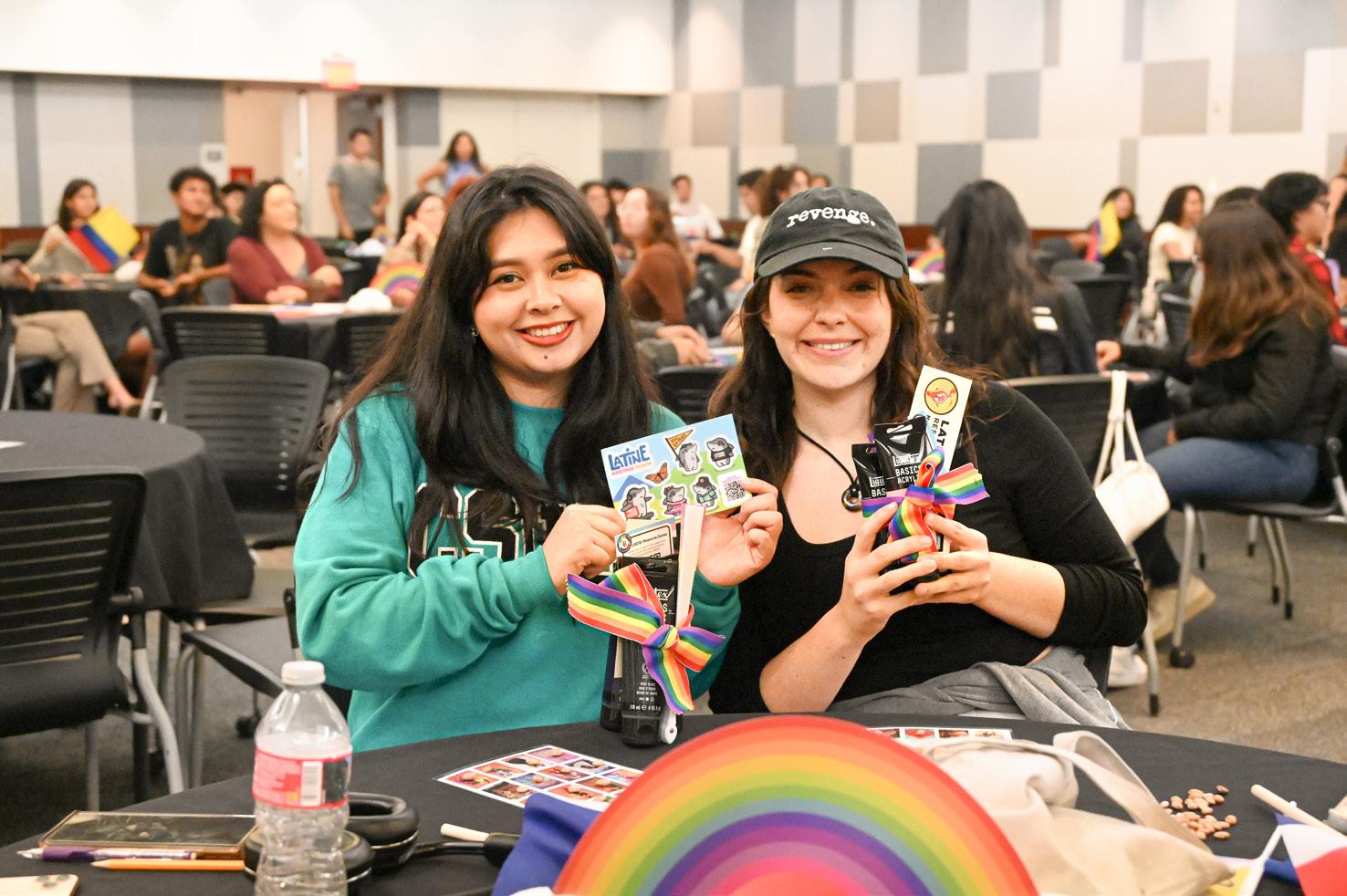
Center, said.
The concept of intersectionality was at the forefront of the event.
“It’s not like you are either queer or LGBT or Latine. Sometimes in people, it’s both, and it’s many more identities. So I think that holding space to recognize that and make that visible to others, it’s extremely important,” Hundreds said.
Hundreds, who won Miss Long Beach Pride 2024, graduated in 2018 and said she
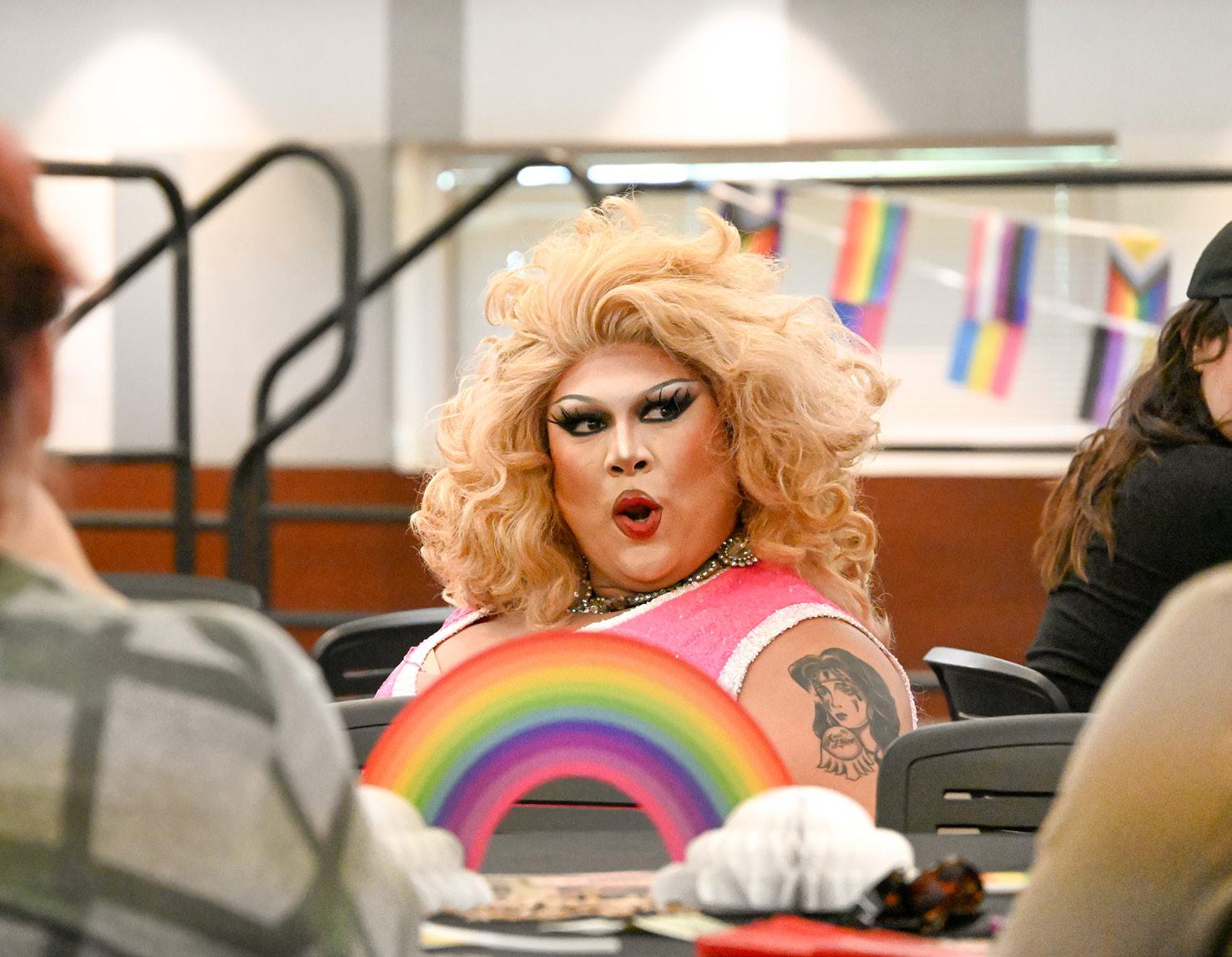
did not see many events such as this during her time at The Beach. She said it’s fun to see new students embrace the culture and to see how much the community has grown.
Hundreds said drag is not a demonic thing as some media portrays it to be, which stems from misinformation.
“Some people may not see it’s (drag) very vital in our community, but go to [an] event without drag and then you’ll see the difference between the two, how much life, how much the Queens, the Kings, the inbetweens bring to the stage,” Darling, who graduated in 2020, said.
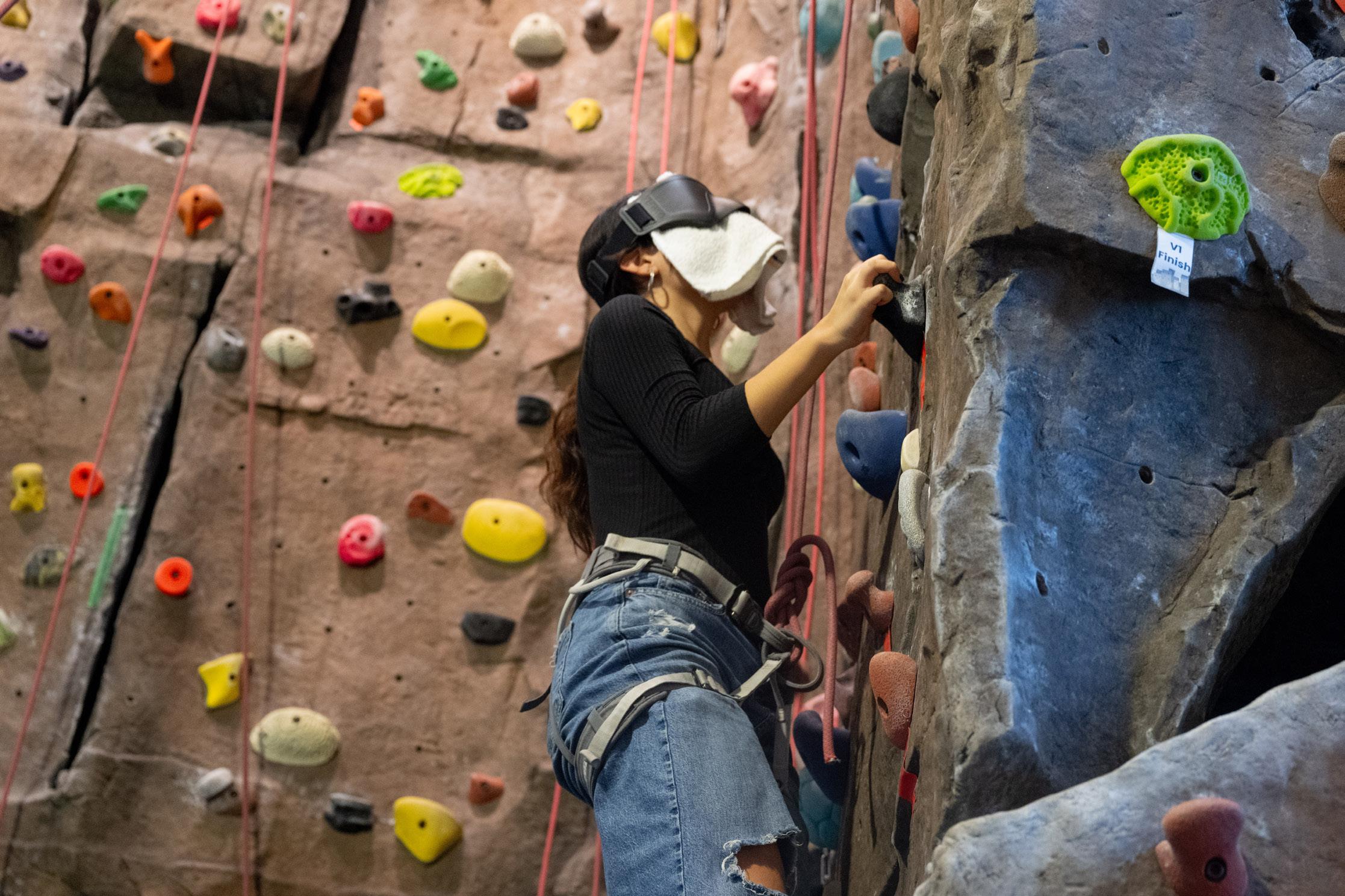
First-year social work student Daniela Sevilla participates in the "Dark Climb" event at the Student Recreational and Wellness Center on Oct. 8. Participants attempted to set the fastest climb time while rock climbing blindfolded.
BY DUPREE DE LA PENA Contributor
Can you walk down the street with your eyes closed?
How about climbing a cliff?
Inside the Student Recreation and Wellness Center on Wednesday, Oct. 8, students gathered to participate in a rock climb with a special blindfold element.
Hosted by the center, the Dark Climb event challenged students to rely on their partners’ guidance while climbing blindfolded.
All participating pairs were entered into a prize raffle.
Dark Climb events are hosted by the Student Recreation and Wellness Center’s
Rock and Outdoor Adventures and the Inclusive Recreation programs, which invite all students to experience rock climbing from the same perspective.
To start, students paired up. While one participant climbed the wall blindfolded, the other guided them with vocal commands.
Event organizers said communication and trust were at the forefront as important factors of success.
This event promotes teamwork while also highlighting accessibility for all students, including those with a visual disability.
“My whole job is about having people feel included in these events,” Riley Keane, the center’s inclusive lead, said. “This one is kind [geared] towards people with visual disabilities. It makes it fair for everybody, and it’s something that everyone can par-
ticipate in, no matter if you have 20/20 vision, wear glasses, or blind. It is for everybody.”
Keane said the event originated as a collaboration between the Intramural Department and the Rock Wall Department, aiming to welcome and introduce students to the rock wall and promote inclusion.
The warm welcome from Keane and the rock wall helpers made an impact on attending students, who smiled and conversed throughout the event.
Students took turns being the vocal guides, and attendees cheered on other climbers as they scaled the wall. Many students met each other for the first time, with newfound friends pairing up for the event.
“I have been rock climbing, but it seemed like a fun social event, because you get to partner up with someone. I even got to meet somebody new,” Dean Hoodman,
a first-year mechanical engineering student, said.
Hoodman and Swayam Pandey, a second-year computer science student, said they randomly came across the event.
“Honestly, I just stumbled right into it,” Pandey said. “He informed me he saw it was taking place today as I was walking up to the gym. So, I asked him if he wanted to partner up.”
SRWC organizers said they host events like this to give students something new to try.
“I hope that participants realize that these are not the most popular events that we have, but they are still fun. I hope that the participants just feel included and advertise it to their friends,” Keane said.
The next rock-climbing event is Coffee and Climb, scheduled for Saturday, Nov. 1, at 9 a.m.
BY DELFINO CAMACHO Arts & Life Editor
You’ve heard of Teenage Mutant Ninja Turtles. But what about Southern California San Gabriel River sea turtles?
The latest installment of the Aquarium of the Pacific’s First Wednesdays lecture series, hosted on Oct. 8 in the sold-out Honda Pacific Visions Theater, spotlighted a local community of green sea turtles who have made their home in an unusually urban environment.
Cassandra Davis, the Aquarium’s volunteer services director, presented the evening’s lecture, officially titled “Sea Turtles of Southern California.”
“The sea turtles along the San Gabriel River are a lot of fun because they’re in an unusual, unexpected place; it’s a very urban environment,” Davis said during the lecture.
Davis’ work focuses on the resident population of green sea turtles found in the local river and surrounding wetlands, along with the aquarium’s volunteer-driven turtle monitoring program, which is organized in collaboration with the National Oceanic and Atmospheric Administration, the Los Cerritos Wetlands Authority and community science networks like iNaturalist.
The concept of volunteering and the importance of community scientists were also a major part of the lecture.
According to Davis, it was volunteers who first began documenting the turtles in 2008 after noticing them surfacing near the Los Cerritos Wetlands, which are undergoing restoration.
Scientists originally thought the sighted green sea turtles, the largest of all hard-shelled sea turtles, were simply tourists passing by Long Beach on their way back home.
“We thought they were transients. We thought they were coming up from Mexico, spending a bit of time here in beautiful Southern California, and then they were heading back,” Davis said. “It turns out that assumption was incorrect.”
The turtles travel more than 3,000 miles to make their home in the local San Gabriel River, following warm currents and returning year after year for the hatching season.
The discovery, Davis said, has reshaped local understanding of how marine life adapts to urban and industrial environments.
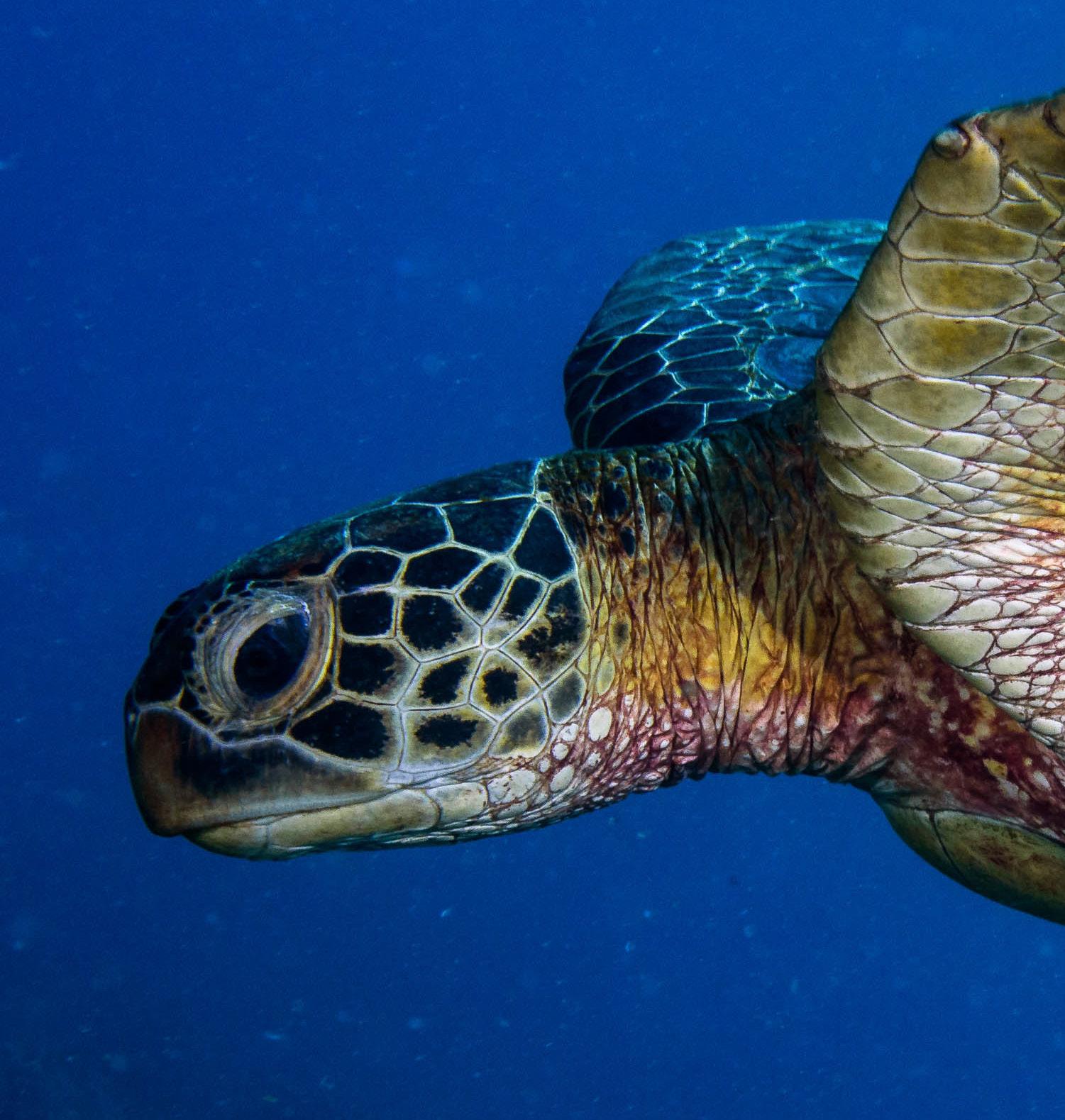
“They weren’t born here. They are transplants, like many Angelenos, and they come from Michoacán and other nesting beaches throughout Mexico,” Davis said.
About 340 trained community scientists now help track sightings and report data each month as part of the Aquarium’s Southern California Sea Turtle Monitoring Project.
Their observations revealed that the turtles likely migrated from Mexican beaches over 3,000 miles away, and have since become a year-round population.
Community scientists are stationed along a two-mile stretch of the river near the Los Cerritos Wetlands restoration area.
Ten observation stations allow them to record where and when turtles surface for air, most often at “station three,” where their favorite food, sea lettuce and algae, grows in abundance.
Volunteers are essential to the project, with many discoveries originating from community scientists. Through these observant volunteers, scientists have realized sea turtle river populations are not in small pockets as once thought, but thriving communities that can reach over 100.
Beyond monitoring, the Aquarium also partners with organizations to rehabilitate turtles in distress. For Davis, one of the most meaningful parts of her work is the connection between science and the public.
“I mean, science is individual curiosity, so participating
in it is incredible,” she said after the lecture. “You can do real science work any day, anytime.”
After the 50-minute lecture, attendees were invited to mingle in the lobby, enjoy drinks and speak with Davis.
Among the crowd were sisters Audrey and Emma Yosanovich, who first heard about the event on TikTok.
“I didn’t imagine sea turtles would be that close to home,” Audrey Yosanovich, 24, said. “It’s just so local. I didn’t expect to hear about the San Gabriel River at all.”
As recent college graduates, the Yosanovich sisters said they now make attending “First Wednesdays” part of their monthly routine.
“It’s a fun, affordable way to learn something new and feel part of a community,” Emma Yosanovich, 21, said. “I miss going to lectures.”
Also in attendance was local resident Jenny Bapp, proudly wearing a shirt covered in turtles.
Bapp, who has a chronic illness, discovered the aquarium’s monthly events this summer, and they quickly became something to look forward to, partly due to their accessibility.
“These events are sometimes like my bright spot in my day,” she said. “It’s just fun. You never know what you’re gonna learn.”
The First Wednesdays series is open to the community for $5 pre-sale and $10 at the door.
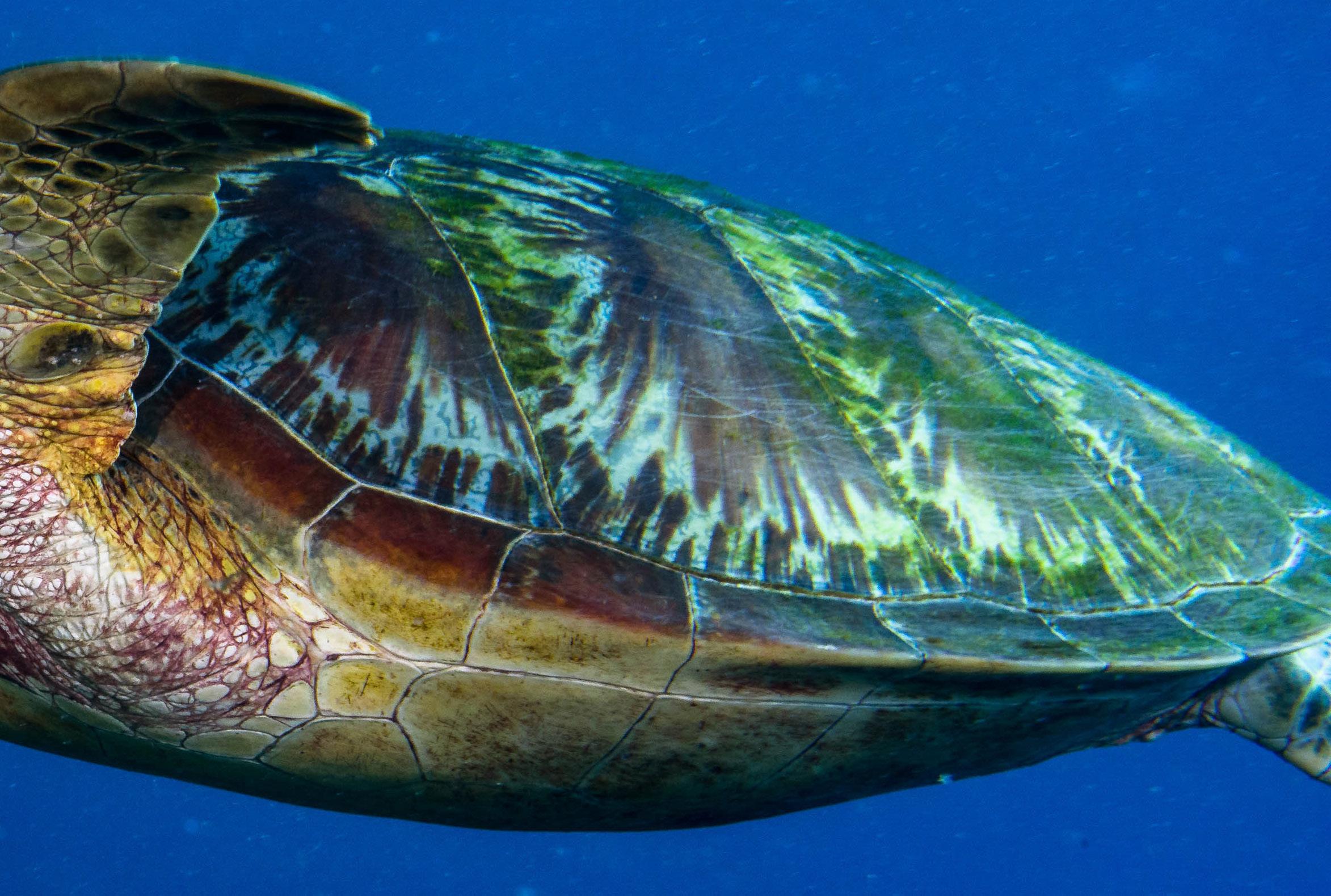
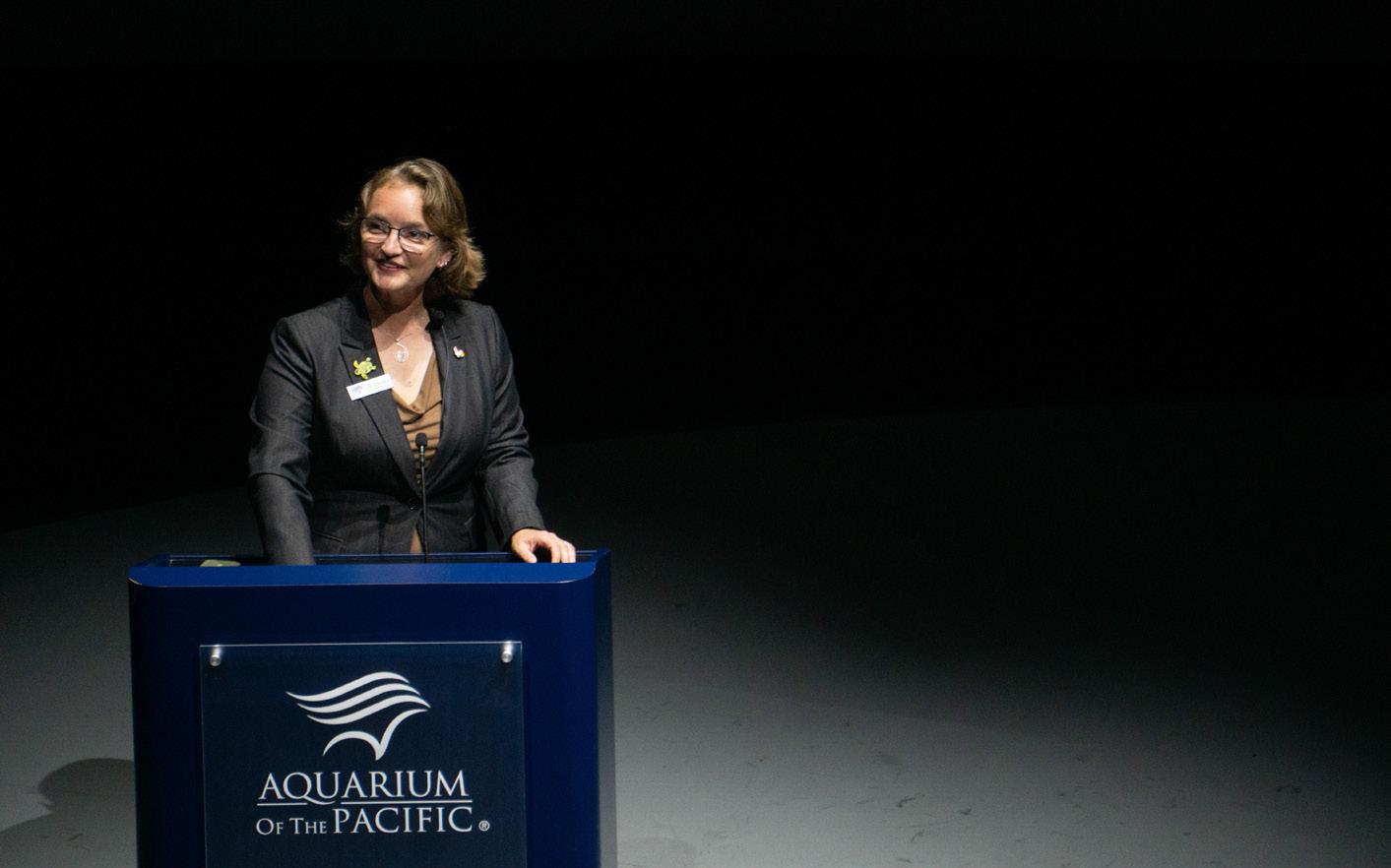
DELFINO CAMACHO/Long Beach
Current
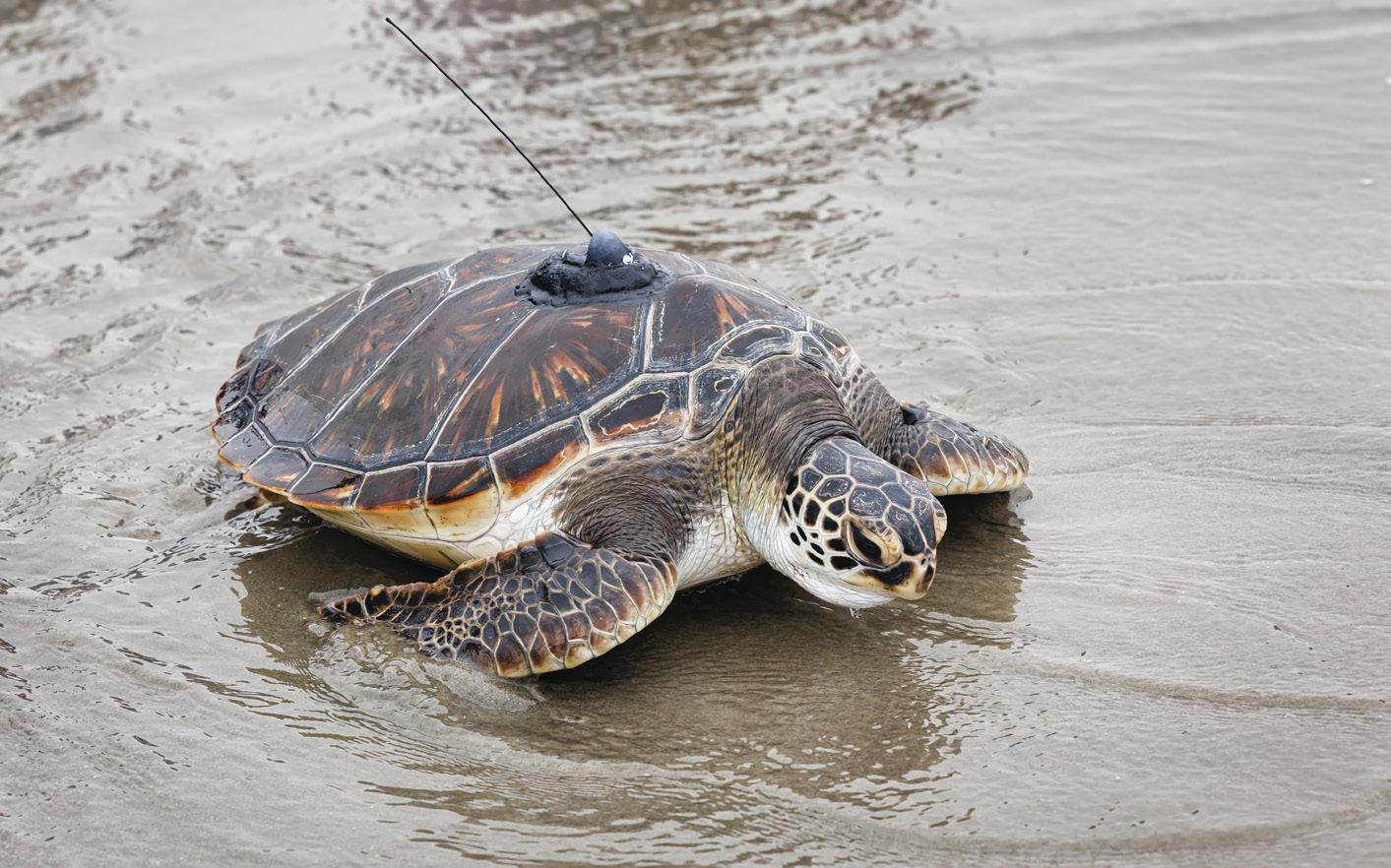
BY JOSH GENTLE Contributor
Bask among bonsai trees older than the United States and koi fish up to four feet long at the Earl Burns Miller Japanese Garden for an afternoon of artistry and relaxation on Thursday, Oct. 16, from 4 p.m. to 5 p.m.
If you’re lucky, you might spot Harry, the Great Blue Heron, who frequents the garden in the early morning and late afternoon, looking for his next meal.
Art Days at the garden happen every third week of the month. Each event focuses on an artistic style or process.
This month, a Japanese calligraphy process known as Sumi-e is on the itinerary. Sumi-e is an age-old technique that involves grinding a hard ink block into powder on a small dish filled with water. The

ink, made from kneading soot and gelatin or resin, is then liquified and applied to a paper of choice. Rice paper is traditionally used.
There is no need to handcraft the ink; Japanese Garden employees will provide supplies to attendees, owing in part to a $2 entry fee.
Sumi-e fans can also bring their own supplies, as long as they are water-soluble.
Omar Navidad, the garden’s events specialist, spoke about the process of Sumi-e and how it embraces imperfection. In traditional practice, lines made in Sumi-e cannot be retouched or tweaked after the initial brushstroke.
“It’s supposed to be something that you are meditating on. You’re really focused on the beauty of each single brushstroke,” he said.
An evening at the Earl Burns Miller Japanese Garden on May 16. Photo cour-
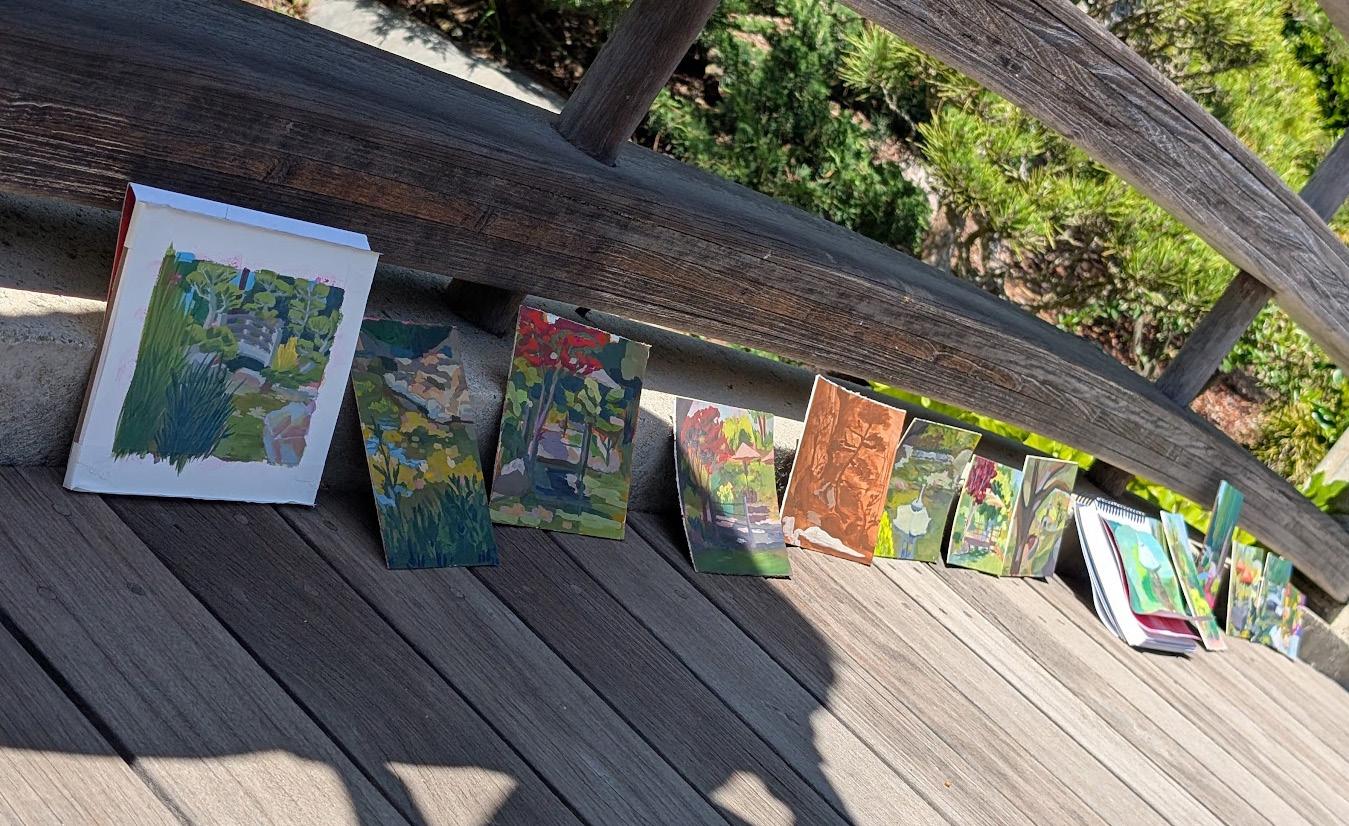
Photo courtesy of the Earl Burns Miller Japanese Garden Paintings from an Art Days event earlier this year sit across a bridge in the Japanese Garden on May 23.
tesy of the Earl Burns Miller Japanese Garden Currently, there are 50 open spots. Omar is hoping for an attendance of 30 to 40 people.
Reservations can be made on the garden’s website.
Several events take place at the garden
throughout the semester, including zen yoga on Wednesdays at noon and 5 p.m. and Fridays at noon, at no cost to students.
For members of the Japanese Garden, a fall event will take place on Sunday, Oct. 18, featuring a taiko drum performance to soundtrack the afternoon, with tea and snacks available to attendees.



BY JOSEPHINE ROBINSON Contributor
The email came on graduation day.
I was sitting in my car, waiting out the student parking lot madness after just waving goodbye to my high school, when the message pinged on my phone, “You have been waitlisted for student housing.”
Everything I was so sure of instantly crumbled before me, and all I could think about as students tripped over themselves to leave our school and suburban town behind was that I was now cemented here.
From the moment I walked the stage, I was in for the long and uncertain road Long Beach State’s housing shortage thrusts you into, and it’s a road walked by thousands of students in the CSU system.
While college is inherently an uncertain place, full of fear, excitement, opportunity and caution, it should still be in our uni-
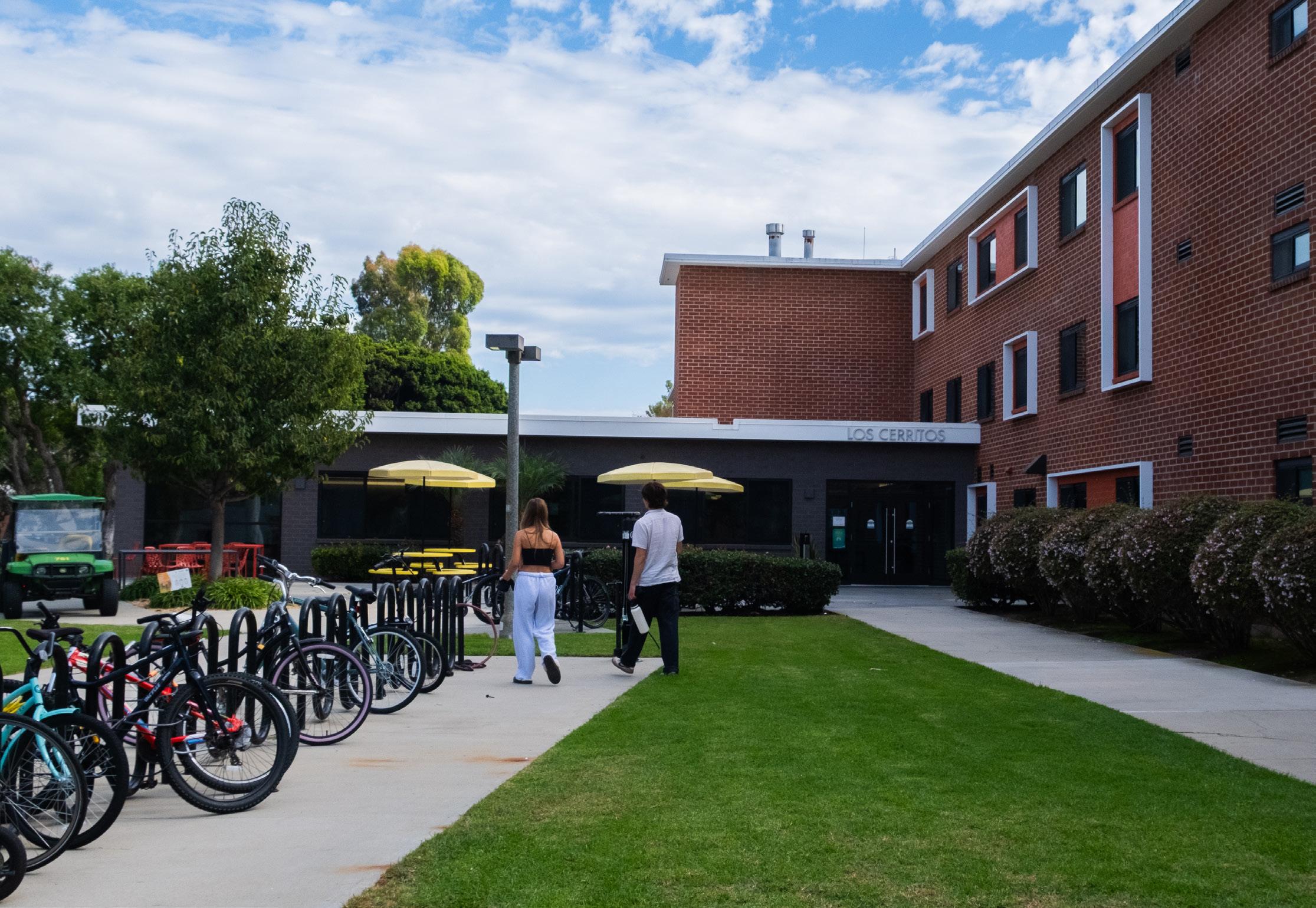
versity’s best interest to ensure that, among all of it, displacement doesn’t have to be a factor.
According to Education Source, “CSU officials say on-campus housing improves students’ graduation rates and could ease housing pressures for Cal State’s 460,000 students.”
This fact is not surprising as people seek connection within a community that is new and exciting. However, how can students plant their roots if they cannot even find a place to live?
The simple fact is there’s not nearly enough housing on our campus for incoming and returning students.
The uncertainty of where students will live goes hand-in-hand with how our school is adapting to the increasing demand for on-campus living.
Recently, the Student Planning Commission approved plans given by the Long Beach City Council to convert an empty office building nearly a block from CSULB’s off-campus Beachside dorms into student housing.
The building is vast, overlooking Rec-
reation Park Golf Course from its head-totoe glass windows, and it could potentially house not only CSULB students, but students attending Long Beach Community College and Pacific Coast University of Law.
While the prospect is an exciting one, I can’t help but remain skeptical. Yes, this could change our student housing crisis exponentially, but will it actually happen?
The building was bought nearly a year ago, and there has been little progress made since then.
This is especially concerning, considering that in February of this year, the city of Long Beach returned a $5.6 million grant for the construction of the Tiny Home campus.
This building plan would have provided sustainable housing to displaced people in Long Beach, alleviating the city’s unhoused issue.
Its construction began in 2023, with Engineering and Art students from CSULB helping design the houses. However, the project was scrapped nearly two years later, wasting the $2.9 million already spent on
construction.
Education Source also reports that “housing accounts for half the cost of attendance at CSU, and that 11% of CSU students surveyed experience homelessness or housing insecurity.”
How can students remain hopeful they will be guaranteed a secure place to live when they are consistently met with “perhaps” and “maybe nots” when it comes to the building of these housing developments?
The construction takeover of our university proclaims a promise of “greater campus life,” but what makes campus greater than an influx of students actually living on it?
University officials must prioritize our students by focusing on ideas that will benefit them, rather than considering potential housing plans or prolonged projects that may take longer than expected.
They must approach student living as a necessity to be fulfilled, ensuring certainty among our students throughout their time at CSULB.
BY TIMOTHY HESSEN Sports Editor
In the pivotal, tie-breaking third set of a match versus a UC Santa Barbara team that stood at the top of the Big West standings, Long Beach State women’s volleyball’s set point was challenged by Gauchos head coach Matt Jones, leading to an extended review.
Leading 24-23 with the fate of the set still hanging in the balance, one might expect to have seen looks of bated breath on the LBSU sideline.
Instead, as music filled the Walter Pyramid while the 1,478 fans in attendance awaited the officials’ ruling, The Beach and Gauchos benches erupted into an impromptu dance battle, with each team challenging each other to build the taller human pyramid before LBSU was awarded the point and set.
The Beach went on to seal the stunning upset 3-1, and their unorthodox response to high-pressure moments is emblematic of a team culture that has head coach Natalie Reagan’s squad far surpassing their preseason expectations.
“I was really enjoying myself; our team’s culture is always amazing,” LBSU redshirt freshman opposite Logan King said. “That’s not our first dance battle and it’s definitely not the last.”
According to veteran senior middle
blocker Nieko Thomas, the team’s closeness and comfortability with each other is a major weapon in the team’s arsenal.
“The team’s really young and with me being the oldest on the team, they make me laugh every single day,” Thomas said.
However, it is not just the power of friendship that fuels a Beach team (12-5) that finds itself near the top spot of the Big West standings with a 5-1 conference record.
The Pyramid has been the home to several emerging stars in the Big West this season, as three LBSU standouts have combined to take home seven individual weekly conference awards, the highest combined total for any team so far.
King has been the biggest story for The Beach in 2025, as the three-time Big West Freshman of the Week ranks third in the conference with 3.63 kills per set. The freshman sensation was also named the conference’s Offensive Player of the Week on Oct. 6, the second LBSU player to receive that title this season.
Preceding her was veteran senior outside hitter Elise Agi, whose return from injury this season, in conjunction with King’s ascendance, has given opposing defenses something to fear from all directions.
Orchestrating a potent Beach offense that ranks first in the conference in points per set is sophomore and two-time Big West Setter of the Week Madi Maxwell, who leads the conference in assists this season with a whopping 611.
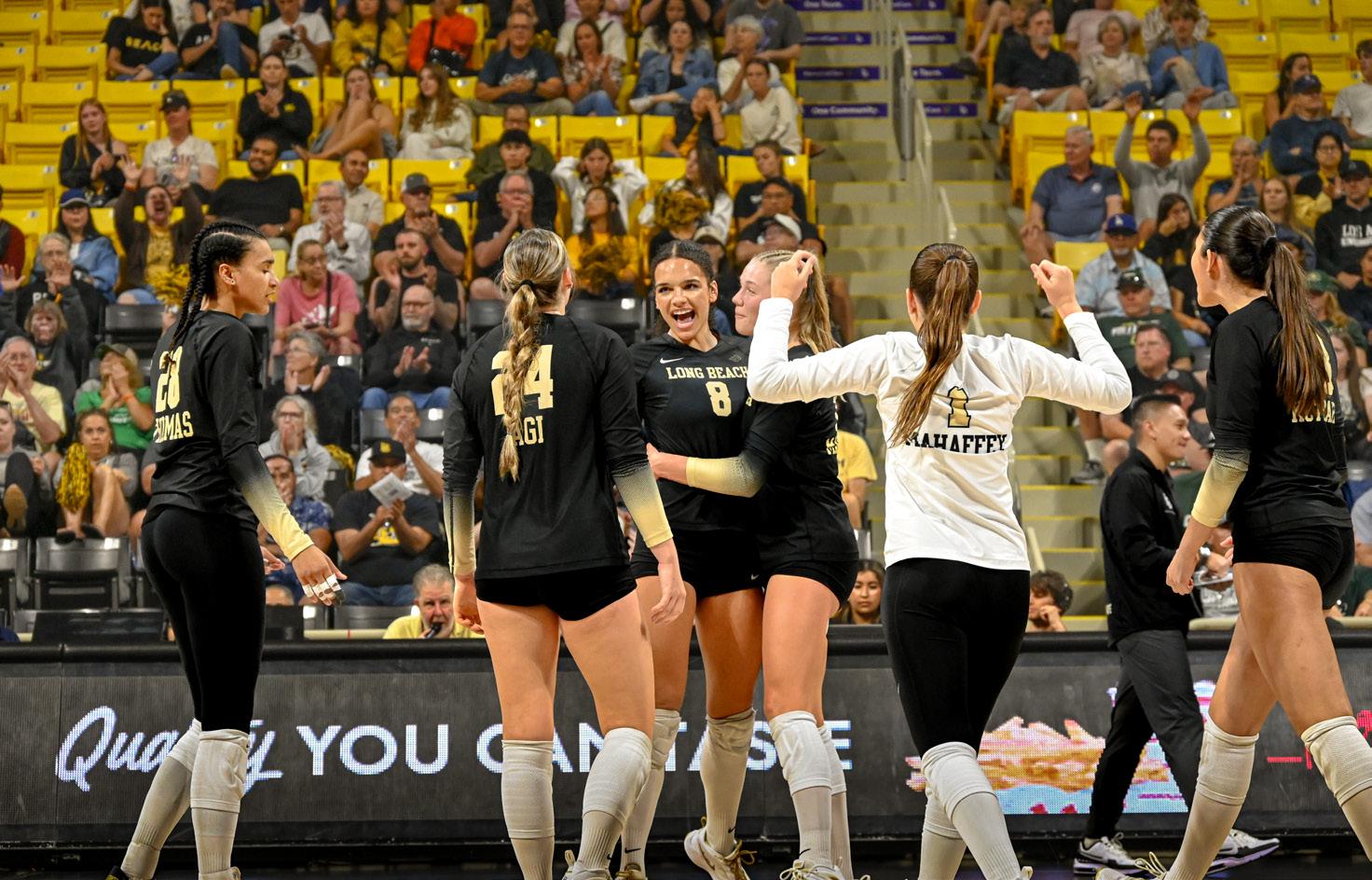
REHANSA KULATILLEKE/Long Beach Current
Senior opposite hitter Logan King (center) celebrates after scoring a point against the Mustangs during the third set. The Beach defeated the Mustangs on Oct. 4 at the Walter Pyramid after a close match.
Reagan’s offensive philosophy is one that prioritizes playing fast and pulling the block with decoy attacks to set up lanes for kills.
According to Reagan, her team has only been able to reach its current level of play after learning from its prior setbacks.
The Beach opted into a grueling non-conference schedule, taking on teams either ranked or receiving votes in the AVCA top 25 national poll, like No. 6 Stanford University and UCLA in closely contested losses.
“Those [games] molded us and prepared us for the moment,” Reagan said.
BY TIMOTHY HESSEN Sports Editor
Big West women’s volleyball powerhouses UC Santa Barbara and Cal Poly San Luis Obispo put themselves on the map early this season, receiving votes in multiple AVCA top 25 polls.
However, after Long Beach State climbed past both formidable units en route to rising near the top of the conference standings, The Beach has yet to receive a single vote of their own in the national rankings.
While it remains difficult for a Big West team to slide its way into a leaderboard that is filled with teams from stacked conferences like the Big Ten and
Big 12, LBSU head coach Natalie Reagan and her squad have demonstrated an ability to compete with some of the best teams in the country.
LBSU lost a nail-biting five-set match to UCLA, which has floated in and out of the top 25 rankings this season, and played No. 6 Stanford to a tightly contested four sets in the season opener.
LBSU’s excellent start to its season should warrant consideration for the next national rankings, but this Beach team that was picked to finish fifth in the conference in the preseason will get the chance to continue to stack wins and defy expectations as it continues through its Big West schedule.
“We foresaw this success coming, and it’s great to see it come to fruition,” Reagan said.
Pamela Badillo claims tennis singles championship
LBSU women’s tennis began its season with a bang at the Big West Fall Tournament on Oct. 5, as Pamela Badillo went 6-0 to take home the singles championship out of a 64-player main draw.
The sophomore from Puebla, Mexico, reached the quarterfinals of the same tournament in her freshman season, but prevailed as the ultimate winner to kick off the 2025 season, defeating University of Hawai’i sophomore Makeilah Nepomuceno in the final round.
Ameera White breaks out for women’s soccer
Taking home her first career Big West Freshman of the Week award on Oct. 6, freshman midfielder Ameera White has emerged as a major contributor for The
LBSU’s early-season trial by fire has produced a squad that is not just elite offensively, but defensively as well.
Behind Thomas’s team-high and conference-leading 72 blocks, The Beach ranks first in the Big West in blocks per set at 2.56.
“A big block is always crazy, it gets everyone hyped, and it can be fuel to hopefully go on a run,” Thomas said.
LBSU will have the opportunity to continue its hot start in Big West play at home against UC San Diego on Oct. 16.
“This team has done a great job on this win streak of finding where we can get better and also recognizing that what we’re doing is paying off and we’re headed in the right direction.”

Beach in her first season.
Ranked third in assists in the Big West with five, White has helped fuel an offense that places third in the conference with 1.5 goals per game.
Despite LBSU’s six-game unbeaten streak being snapped against Cal State Bakersfield on Oct. 9, White and The Beach look to remain serious contenders in the Big West this season.
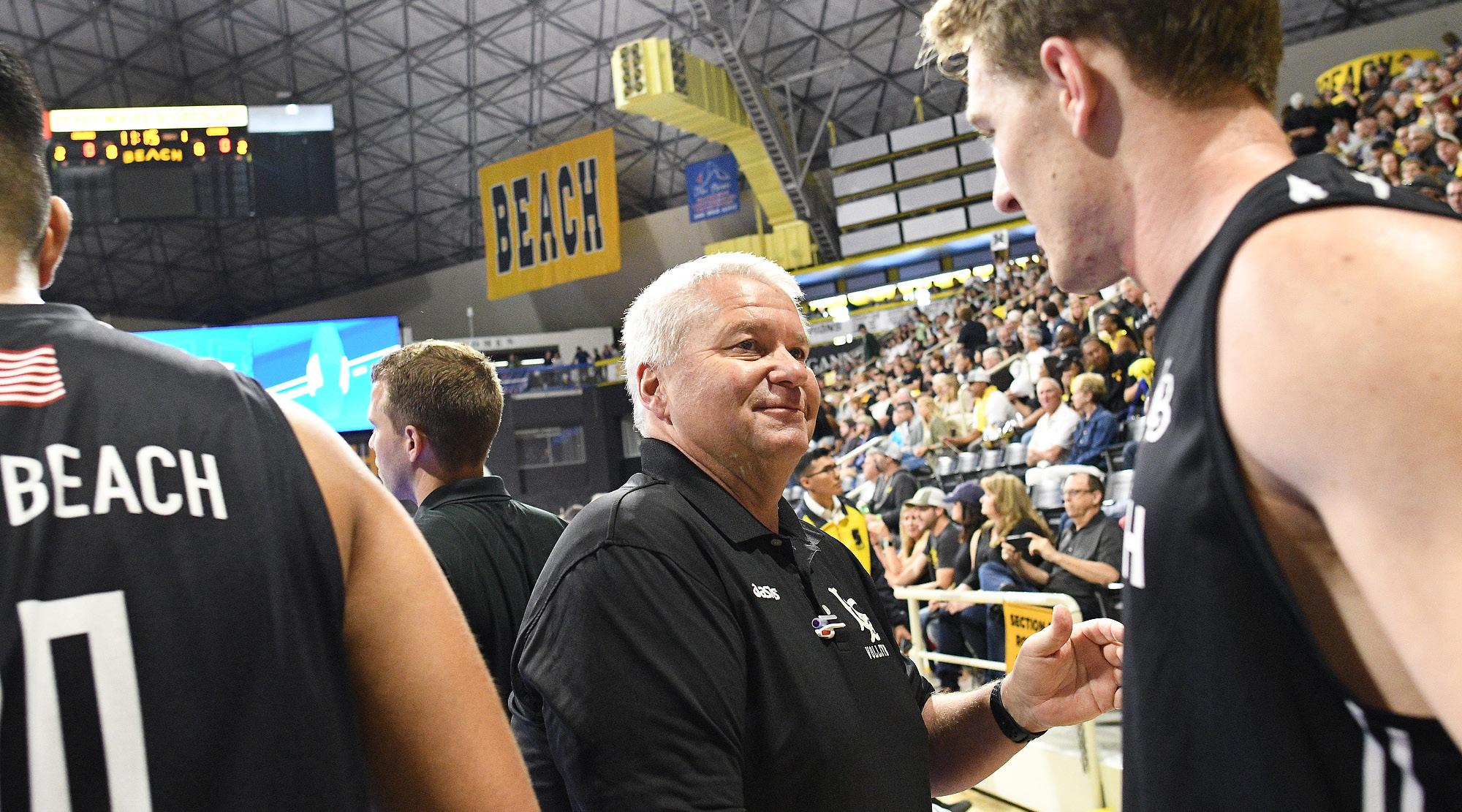
BY BRIANNA APODACA Sports Assistant
After a career with Long Beach State that spans nearly 30 years and three NCAA Championships, assistant men’s volleyball coach Andy Read has concluded his career with The Beach, taking his talents to Team USA Volleyball.
With his steady presence on the sidelines since 1996, Read has contributed to a historic run of success for the program, winning three national titles and 11 conference titles while aiding legendary head coach Alan Knipe in the development of eight players who went on to win National Player of the Year while representing LBSU.
Read’s relationship with Knipe goes
back to 1987, when Read coached Knipe as a player at Marina High School.
From 2010 to 2012, Read took over as interim head coach when Knipe left to coach the Team USA national team.
Read has been a mentor not only to players but his fellow coaching staff.
Associate head coach Nick MacRae, former student athlete at The Beach during Read’s tenure, credits Read with shaping his volleyball career.
“I think [Read] is a perfect reminder of what Long Beach State men’s volleyball is,” MacRae said. “It’s putting your ego aside, being a selfless servant and having that yes mentality and work ethic for the greater good of leaving this program better than he found it.”
Throughout his career, Read played a major role in helping student athletes through mental blocks and slumps while pushing them to play at their highest po-
tential and setting the foundation for their success, both for The Beach and Team USA.
Read’s connection with LBSU athletes has often extended to an international stage, including sophomore middle blocker Isaiah Preuitt, who was part of LBSU’s national title-winning 2025 team before playing under Read at this year’s NORCECA Pan American Cup.
“[Read] really just had the strongest belief in his players,” Preuitt said. “He really just inspired us to want to be the best player we could be and he held us accountable and it's something we’re really gonna miss in the gym for sure.”
Beyond his time with The Beach, Read amassed an extensive international coaching career, winning gold with the Team USA Youth National Team at the NORCECA Championships in 2008 and, most recently, winning gold with the men’s
national team at the Pan American Cup in 2022.
“There’s nothing better than standing on the sidelines and seeing your team lined up on the end line and hearing your national anthem, except when you hear your national anthem at the end of the tournament and your guys are wearing gold medals,” Read said. “There’s not a better feeling, it sends chills down my back every single time; I have to pinch myself and go ‘How did I get here?’”
While he wraps up his career with The Beach, Read will continue to bring his expertise and love for the game to Team USA.
“I want to coach volleyball as long as I'm effective at it and I enjoy it; when either one of those don’t happen I gotta step away,” Read said.
BY MONICA BADOLIAN Sports Assistant
For Long Beach State senior men’s golfer Jaden Huggins, golf is not just a sport but a lifelong pursuit of growth, resilience and balance.
Referred to as the “glue guy” on the team by LBSU head coach Rob Murray, the Murrieta, California native brings a laid-back personality and relentless work ethic that sets him apart on and off the course.
“He’s friends with everybody,” Murray said. “I think he’s kind of the guy who holds the team together, with a fun, jokester personality.”
Huggins, 22, recalls being a toddler, watching his dad hit golf balls in the backyard, prompting the future LBSU star to grab a club and start swinging.
That moment sparked a lifelong passion that has carried him to LBSU, where the senior has become a two-time All-Big West Honorable Mention and one of the most skilled players in the men’s golf program.
In July 2025, Huggins took home the Southern California Golf Association Amateur Championship.
Resilience has defined Huggins’ collegiate career.
After earning All-Big West Honorable Mention honors in his first two seasons, he faced a major setback when a broken bone in his hand cut his junior year short after competing in just three tournaments.
Instead of letting the injury get the
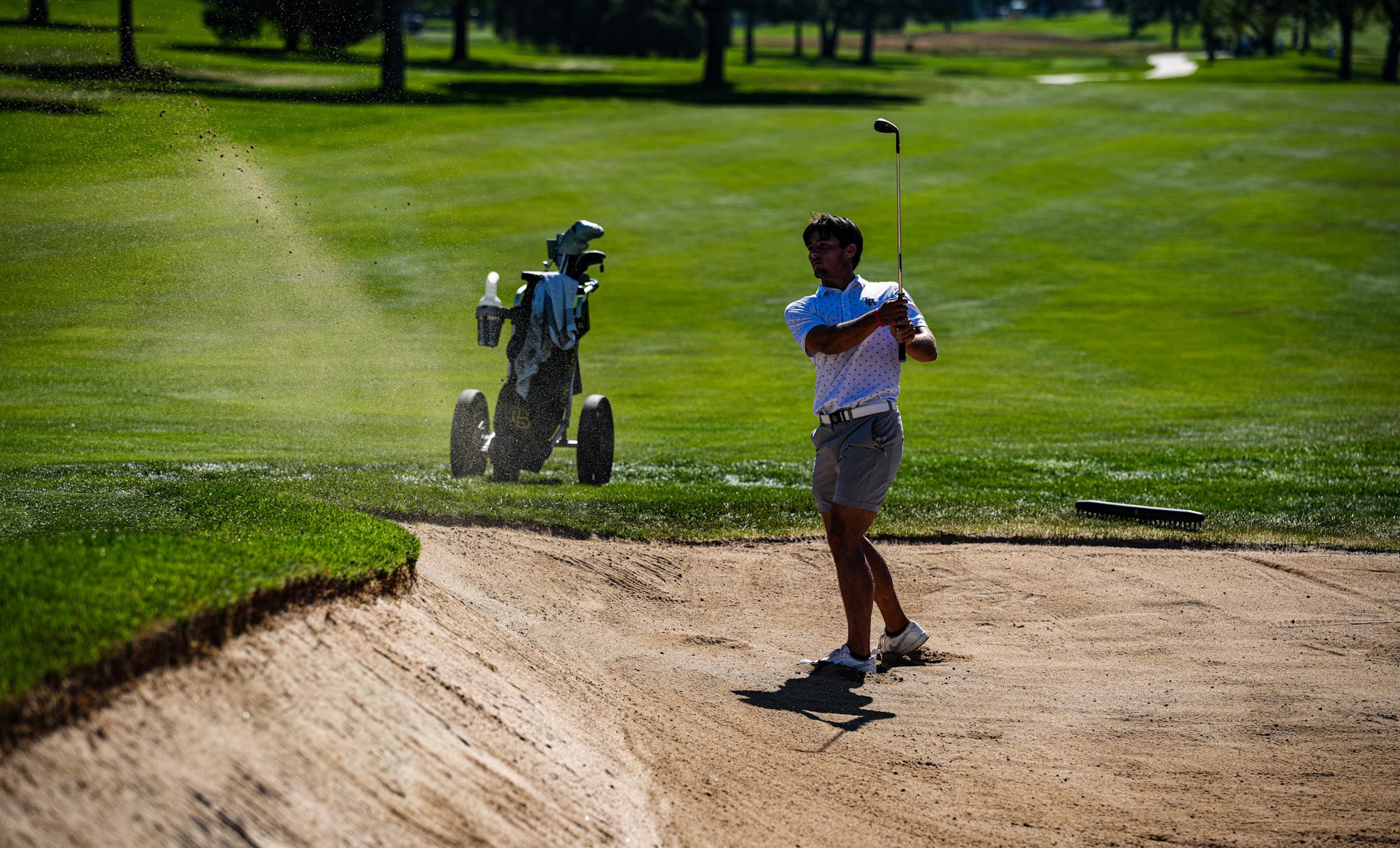
best of him, Huggins used the time away from the golf course to train and focus on his mental well-being.
“Golf can be frustrating; it’s one of those sports where you fail way more than you succeed,” Huggins said. “I’ve had to learn how to stay calm and not get too down on myself; I try to use every tough round or every bad break as a chance to grow.”
By focusing on his mental health, Huggins gained strength in other ways.
“My work ethic really grew during that time,” Huggins said. “I couldn’t play, so I found other ways to get better, whether it was workouts, mental focus, or just being around the team. It made me appreciate the game even more.”
His laid-back personality helps him navigate the mental grind. Huggins describes himself as someone who tries not to overthink and overcomplicate the game.
“I try to keep my head down, keep working, and not let the pressure get to me,” Huggins said. “If you stay patient, the results come.”
Murray describes Huggins as an “elite ball striker” who creates scoring chances with his length off the tee, while also pushing himself to sharpen his
short game.
Huggins’ balance of a relaxed personality but a laser focus on improvement has yielded results in his return from injury.
LBSU emerged as the winners of its first two tournaments of this season, capturing back-to-back victories for the fifth time in program history.
Huggins finished with the tied-fourth best individual score to lead The Beach in their victory at the William H. Tucker Invitational in New Mexico on Sept. 20.
While golf is often seen as an individual sport, Huggins deeply values the bond he shares with his teammates.
“The team dynamic is great,” Huggins said. “We all joke the whole time on the road, and when it’s time to focus up, we focus up.”
While the senior star looks to continue leading The Beach this season in what is expected to be a banner year for the program, Huggins also has his sights set on playing professionally after college.
“That’s something I’ve always wanted, and I’ve been working for basically my whole life,” Huggins said.
Throughout Huggins’s journey at The Beach, from a promising freshman season to a tenacious return from injury,
Murray believes Huggins has a chance to take golf even further.
“The sky’s the limit,” Murray said. “He’s got potential, he’s got athletic ability, and he’s already showing that here.”